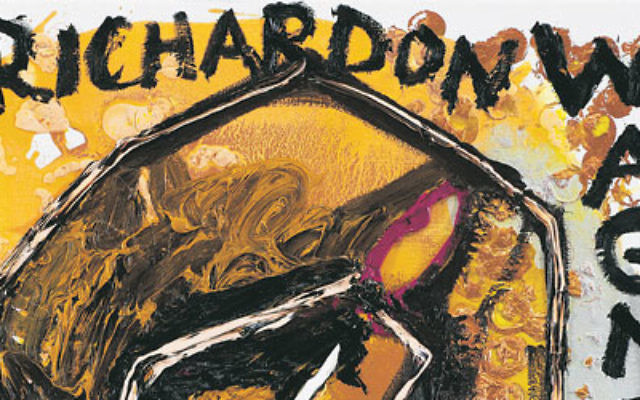Leitmotif in Leipzig
FOR opera buffs and concert enthusiasts around the world, Richard Wagner is the centre of attention with events marking the 200th anniversary of his birthday.
But for the international Jewish community, a year saturated in homage to classical music’s most infamous anti-Semite is a fraught one indeed.
Wherever Wagner goes, controversy follows. A recent Düsselforf production of Tannhäuser, featuring dancers in a transparent gas chamber and Venus dressed as an SS officer, was pulled after an opening night plagued with boos, walk-outs and the hospitalisation of traumatised viewers.
In the Bayreuth Festspielhaus – Wagner’s own purpose-built theatre – audiences didn’t take too kindly to Frank Castorf’s Siegfried, complete with “blowjobs, crocodiles and a communist Mount Rushmore”, according to Die Welt’s unamused critic.
Amid one international scandal after the next, it has been easy for the world to forget about what’s happening in Wagner’s hometown, Leipzig, known as a Musikstadt and a major hub for classical music since the golden era of J S Bach.
The central German city, situated about 150 kilometres south of Berlin and with a population of 500,000, has quietly staged one of the most diverse jubilee programs on offer this year, addressing the blight of anti-Semitism without resorting to copulating reptiles.
Awkwardly, the glut of Wagner festival events in Leipzig rolled out just a few weeks before the city’s Shalom Jewish Week in June.
Wagner was born on May 22, 1813, on the Brühl (a famous street) in the Saxon city’s Jewish quarter. After his father died, the family moved to nearby Dresden. But in 1828 the budding young composer returned to Leipzig to study at the Alte Nikolaischule, where he was, by his own admission, “lazy and dissolute”.
This year, his alma mater inaugurated a new museum dedicated to his formative years in Leipzig up to the age of 21. Prominently displayed alongside a little-known portrait of the formidable maestro as a rosy-cheeked lad are signs of his clear sense of purpose – and his burgeoning ego.
It was just after this period, in 1835, that the brilliant young composer Felix Mendelssohn became the conductor of the town’s Gewandhausorchester. The struggling Wagner submitted to his successful rival a “gift” of a Symphony in C major in the hopes it would be premiered by the Gewandhaus, but it was never heard under Mendelssohn’s baton.
This early rejection was one of the experiences that informed Wagner’s venomous 1850 tract Judaism in Music, in which he accused Mendelssohn of turning Leipzig into a “metropolis of Jews’ music”, and denounced several established Jewish composers as “demons hostile to art”.
Fast-forward to the composer’s 200th birthday celebrations and it is the same grand Gewandhaus, renowned as one of Europe’s finest orchestras, playing in Wagner’s early opera Die Feen (The Fairies), along with Rienzi, The Flying Dutchman, Parsifal and other performances.
In various exhibitions about town, it’s clear that the attitudes of contemporary artists, challenging the impact of Wagnerian themes on German cultural consciousness, range from irreverence to ambivalence to outright revulsion.
In Mythos Wagner at the elegant Klinger Forum on Karl-Heine-Strasse, a haunting Anselm Kiefer collage of Brünnhilde’s skeletal horse on its funeral pyre is viewed alongside more playful works by the younger generation, such as Thorsten Brinkmann’s self-portraits as a Valkyrie.
Jonathan Meese’s angular, 2D graffiti paintings depict the composer donning his distinctive oversized black Wagnerkappe, with bold political titles such as Kein Dreckskonsens (No dirty conscience).
Recently acquitted of charges relating to Nazi salutes he made in public as part of a forum discussion at an event titled “Megalomania in the Art World”, Meese has been hired to direct The Ring in Bayreuth for the 2016 festival.
A lighthearted take on Wagner displayed at the Commerzbank Leipzig, Matthias Ose’s collection of 70 small watercolour caricatures tells the composer’s life story.
They impart a charm and whimsy rarely associated with Wagner, with only one drawing addressing the vexed question of his anti-Semitism (Das Judenthum in der Musik) and another touching on the Wagner family’s latter-day relationship with Hitler.
On the big day, May 22, Leipzig’s Wagner festivities culminated in the unveiling of a new statue by Stephan Balkenhol. Behind the squat, life-size figure looms a solid four-metre shadow, all atop the immense marble pedestal.
Even as Wagner’s music reaches the most dizzying artistic heights, its posthumous Nazi associations and his own well-documented hatred of Jews cast an ominous shadow on German culture. Leipzig has dared to cut its homegrown titan down to size.
REPORT by Melissa Lesnie
PHOTO of Jonathan Meese’s graffiti-style artwork of composer Richard Wagner that was on display in Leipzig earlier this year.


comments